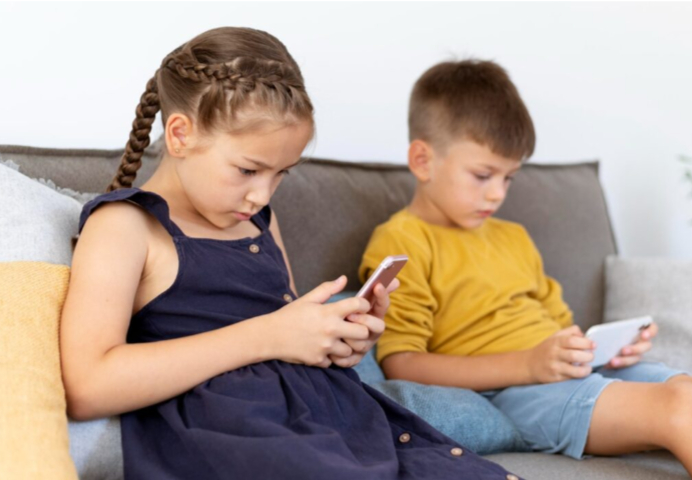With screens present almost everywhere, it can be difficult to keep track of a child’s screen time. Additionally, some screen usage can be educational and aid in children’s social growth. So, how can you regulate your child’s screen time? Here’s a guide to directing your child’s interaction with screens and media.
The issues associated with screens
Excessive screen time and frequent exposure to low-quality content have been associated with:
- Obesity
- Irregular sleep patterns and inadequate sleep
- Behavioral issues
- Delays in language and social skills
- Exposure to violence
- Attention deficits
- Reduced learning time
It’s important to remember that unstructured play is more beneficial for a young child’s developing brain than electronic media. Children under the age of 2 generally learn better when engaging and playing with parents, siblings, and other children or adults.
By the age of 2, children may gain from certain types of screen time, such as programs that incorporate music, movement, and narratives. Watching together allows you to assist your child in comprehending what they see and applying it in real life. However, passive screen time should not replace reading, playing, or problem-solving activities.
Creating screen time guidelines
The American Academy of Pediatrics advises against media use, except for video calls, by children younger than 18 months. If you decide to introduce digital media to children aged 18 to 24 months, ensure it is of high quality and avoid unsupervised media use. For children aged 2 to 5, restrict screen time to one hour a day with high-quality programming.
As your child matures, a universal approach may not be as effective. You’ll need to determine daily media usage and what is suitable for your child.
Consider implementing the same rules for your child’s physical and virtual settings. In both environments, engage in play with your child, promote kindness, be involved, and understand your child’s friends and their activities. Remember, the quality of media exposure is more crucial than the type of technology or the amount of screen time.
To ensure high-quality screen time:
- Review programs, games, and apps before allowing your child to use them. Resources such as Common Sense Media offer ratings and reviews to help you find age-appropriate content. Ideally, engage with these activities alongside your child.
- Look for interactive options that captivate your child, rather than those that only involve simple tapping or staring at the screen.
- Utilize parental controls to limit or filter online content.
Keep your child nearby during screen time for better supervision of their activities. - Regularly ask your child about the programs, games, and apps they interacted with that day.
- When viewing content with your child, discuss what’s on the screen, and teach them about advertising and commercials.
- Avoid fast-paced shows, which young children often find hard to grasp, violent content, and apps with distracting elements. Remove advertisements from apps, as young children struggle to distinguish ads from factual content.
Setting boundaries for older children
Establish clear guidelines and practical limits on your child’s digital media usage. Consider the following suggestions:
- Encourage screen-free, spontaneous playtime.
- Designate tech-free zones or times, like during meals or one evening each week.
- Discourage media entertainment while doing homework.
- Set and enforce daily or weekly screen time limits and curfews, such as no device usage an hour before bedtime.
- Consider employing apps that manage the duration for which a child can use a device.
- Keep screens out of your child’s bedroom, and possibly require them to charge devices outside their rooms at night.
- Eliminate background television noise.
Promoting digital literacy
Eventually, your child will come across content that you haven’t pre-approved and devices without internet filters. Discuss potential situations with your child and clarify the behavior you expect.
Encourage your child to engage critically with what they view on their screens. Ask them to consider the accuracy of information found online. Does your child know how to assess the trustworthiness of a website? Help them understand that media is created by individuals with specific viewpoints, and many types of technology gather data to deliver advertisements or generate revenue.
Teaching Appropriate Behavior
Digital connections and social media have become integral to the lives of teenagers. Specialists indicate that it is acceptable for your teenager to engage in these platforms, provided they grasp what constitutes appropriate conduct. Clarify what actions are permissible and which are not, including sexting, cyberbullying, and the sharing of personal information online. Educate your teenager on the importance of refraining from sending or sharing anything online that they wouldn’t want the whole world to view permanently.
Regardless of how intelligent or mature you believe your child to be, it’s essential to keep an eye on their online and social media activities. Mistakes are inevitable when navigating media, so it is important to discuss these with your child and assist them in learning from their missteps.
Moreover, it is crucial to set a positive example. Keep in mind that your child observes you for guidance on when and how to utilize screens.
You will probably need to keep guiding, managing, and monitoring your child’s use of screens and media as they mature. However, by establishing household rules and revisiting them as your child ages, you can help facilitate a safe experience.
How Does Screen Time Impact a Child’s Ability to Learn?
For a young child, every experience is novel. Children require hands-on exploration of their surroundings through all their senses to understand the world, which makes it vital for them to engage in three-dimensional activities rather than simply viewing two-dimensional images on a screen.
Research indicates that children under the age of 2 gain less knowledge from videos compared to learning from direct interaction with another person, and while children may watch a screen as early as 6 months, true comprehension typically does not happen until they are over 2 years of age. Although they may be fascinated by what they see on screen, they are not absorbing educational content.
A child won’t learn to stack blocks merely by observing it on a screen; they acquire that skill by physically manipulating the blocks, experiencing their texture and weight, and using trial and error to achieve balance. This kind of hands-on play encourages early problem-solving. Therefore, in addition to limiting screen time, it is crucial to promote experiential learning through play with toys, as this nurtures creativity and problem-solving abilities.
Language acquisition sees significant growth between 1.5 to 3 years old, and studies suggest that children learn best when they are engaged in interaction with adults who converse and play with them. There is also evidence hinting that children who watch a lot of television during early elementary years tend to perform poorly on reading assessments and may exhibit attention challenges.
Tell Us More About How Screen Time Affects Language and Communication
Studies demonstrate that engaging in reciprocal conversations with children is vital for their language development and social skills. This back-and-forth exchange, involving shared facial expressions and real-time reactions, enhances language and communication abilities in young children far more effectively than passive listening or one-sided interactions with screens.
What Age Is Appropriate to Introduce Screens?
The American Academy of Pediatrics (AAP) advises against screen use for children younger than 18 to 24 months, except during video calls with family. Additionally, for preschool-aged children from 2 to 5 years old, the AAP suggests limiting screen time to just one hour per day of quality programming (like Sesame Street or PBS).
When household tasks require attention, it can be beneficial to occupy a young child with engaging entertainment. In this case, I recommend that parents opt for a brief educational TV show, such as Sesame Street or Daniel Tiger’s Neighborhood, which demonstrates interactions and cooperative play that promote positive social behaviors, rather than giving the child a tablet or phone. Furthermore, when feasible, watching the educational content alongside the child is ideal so that you can actively participate in discussions about what they are viewing and learning.
How can screens affect a child’s sleep?
Human circadian rhythms and melatonin production, the hormone responsible for sleep, begin to activate as the sun goes down. However, the blue light emitted by screens hinders melatonin production, which can postpone sleep. Engaging in activities like watching TV or gaming also keeps our brains and bodies alert and active, making it harder to wind down for sleep. (Screens on tablets and smartphones tend to interfere with melatonin production more than TVs since they are positioned closer to the face.)
A study found that infants aged 6 to 12 months who had screen exposure during the evening experienced notably shorter sleep duration at night compared to those without evening screen time.
For preteens and teenagers, too much screen usage late at night can disrupt their sleep, so it’s recommended to keep screens out of the bedroom. Excessive social media use along with lack of sleep can negatively influence behavior and cognitive performance in school, hindering learning. Additionally, there is a connection between excessive screen time and sleep deprivation with obesity, which can impact self-esteem and result in social isolation and further screen time.
How addictive can screens be for young children?
Mobile devices have a compelling nature that draws users in, and it’s all too easy to spend hours browsing the internet. They are so easily portable and available that they become hard to live without. While adults can recognize the downsides and consciously choose to unplug, 2- or 3-year-olds, who may not comprehend these issues, can become accustomed to phone or tablet use from an early age, leading them to crave even more engagement.
We should also be cautious about using screens as a distraction for children when they encounter issues instead of allowing them to learn to solve problems independently. For instance, distracting a young child with a favorite song after they’ve fallen and hurt themselves might be a suitable response, but it’s more beneficial for a parent to comfort and talk to the child. Similarly, resorting to screens to distract children who struggle with sharing toys won’t help them learn the important skills of sharing and taking turns in the long run, despite being a quick solution in the moment.
Are some screens more detrimental than others?
Television is not as harmful as it was once thought to be, as it can be more easily monitored and remains in a fixed location. Conversely, tablets and smartphones are more concerning due to their portability, allowing them to be used anywhere at any time.
In my view, YouTube is often detrimental for young children. If given the freedom to explore, children can quickly discover their favorite videos and follow links to others, leading to prolonged periods of watching endless content. The largely unregulated nature of the platform allows them to access nearly anything; at best, it provides minimal educational benefit, and at worst, it may expose them to violent or inappropriate material. Ideally, parents should engage with their children while watching to help select content that is both suitable and educational.



